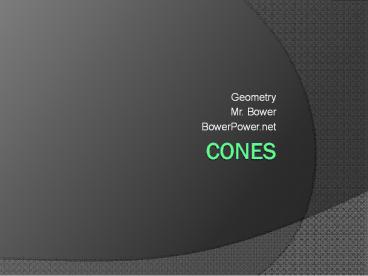Cones - PowerPoint PPT Presentation
Title:
Cones
Description:
Geometry Mr. Bower BowerPower.net What is a cone? When you spin a right triangle (using one of the legs as an axis), you get a cone Cones vs. Pyramids How are cones ... – PowerPoint PPT presentation
Number of Views:188
Avg rating:3.0/5.0
Title: Cones
1
Cones
- Geometry
- Mr. Bower
- BowerPower.net
2
What is a cone?
- When you spin a right triangle (using one of the
legs as an axis), you get a cone
3
Cones vs. Pyramids
- How are cones and pyramids similar?
4
Cones vs. Pyramids
- How are cones and pyramids similar?
- How are cones and pyramids different?
5
Parts of a cone
APEX
- The apex is the point at the top of the cone
6
Parts of a cone
- The base is the circle at the bottom (or top, if
youre eating ice cream!) of the cone - The radius of that circle is called r.
BASE
7
Parts of a cone
- The perpendicular distance from the circular base
to the apex is the height, which we call h.
8
Parts of a cone
- The slant height, which we call l, is the
distance from the apex to a point on the circle.
9
Right triangle in a cone
10
Cone Lateral Area
11
Cone Surface Area
12
Cone Volume
13
Cone Example
- A cone has a height of 8 cm and a slant height of
10 cm. - Find the cones
- Lateral Area
- Surface Area
- Volume
14
Cone Example How to start
- A cone has a height of 8 cm and a slant height of
10 cm. - Lets start by making sure we know
- h, r, and l.
15
Cone Example How to start
- A cone has a height of 8 cm and a slant height of
10 cm. - h 8 and l 10
- We need to calculate r.
16
Cone Example How to start
17
Cone Example How to start
18
Cone Example How to start
19
Cone Example How to start
20
Cone Example How to start
21
Cone Example Lateral Area
22
Cone Example Lateral Area
23
Cone Example Lateral Area
24
Cone Example Surface Area
25
Cone Example Surface Area
26
Cone Example Surface Area
27
Cone Example Surface Area
28
Cone Example Volume
29
Cone Example Volume
30
Cone Example Volume
31
Cone Example Volume
32
Cone Summary
33
BowerPower.net































